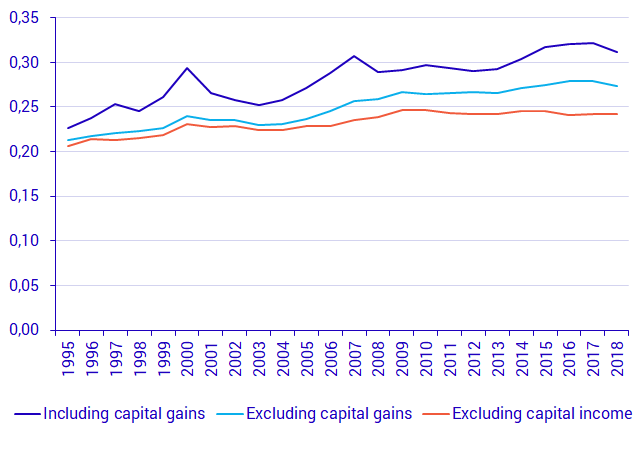Income and taxes 2018, final
Income growth rate slowing
Statistical news from Statistics Sweden 2020-01-29 9.30
Households’ economic standard continued to increase in 2018, albeit at a slower rate than a few years ago. The median amount for the economic standard was 0.8 percent higher than in 2017, taking inflation into account. Statistics on households’ incomes and taxes show that the economic standard has increased by 14 percent since 2011.
Households’ economic standard increased by 0.8 percent in 2018 and also increased by just under 3 percent in the three-year period 2015-2018. In the previous three-year period, 2012-2015, the increase was 9 percent.
Income gaps narrowed in the past year
As measured by the Gini coefficient, income gaps decreased in 2018 to the lowest level since 2014, both including and excluding capital gain. When all income from capital is omitted, income disparities remained unchanged between 2017 and 2018. When income from capital is omitted, differences in income were relatively stable in the 2010s. However, over a longer period, income disparities have increased.

Steady at-risk-of-poverty rate
The at-risk-of-poverty rate decreased slightly in 2018 from 14.9 percent to 14.6 percent. This share has hovered between 13 percent and 15 percent since 2008. A major increase occurred between 2003 and 2011, when the share increased from 8.9 percent to 14.4 percent.
More than 25 percent of income to highest income decile
In 2018, the half of the population with the lowest income level accounted for about 30 percent of total disposable income. This share has remained relatively constant in the past ten years; in the late 1990s, it was 34 percent. The highest income decile accounted for just over 26 percent of total disposable income in 2018. This is a decrease of one percentage point compared with 2017, but an increase of three percentage points compared with the late 1990s.
Income gap between Swedish born persons and foreign born persons remains constant
The economic standard is lower among foreign born persons than among Swedish born persons. In 2018, the economic standard among foreign born persons corresponded to 77 percent of the economic standard among Swedish born persons. This ratio has remained relatively constant in the past ten years. However, in the ten years prior to that, this ratio decreased sharply from 84 percent to 77 percent.
Poorer development for persons who are ill and unemployed persons
Income growth was less favourable for persons who are ill and unemployed persons. Since 2011, the economic standard has increased by 3 percent for unemployed persons and by 6 percent for persons who are ill. Among retired persons and students, this increase was slightly higher, 16 percent and 17 percent respectively, than among the total population.
Best progress for young women
Between 2011 and 2018, there was a strong development for young women. Among single women aged 20-29 years without children, income growth was 28 percent. The corresponding increase among young men without children was 19 percent. The development among single persons aged 65-79 years was less favourable. Between 2011 and 2018, the economic standard increased by 13 percent for women and by 12 percent for men. The development for families with children largely followed the development for the total population.
100 000 persons with salary of more than one million Swedish kronor
The year 2018 was the first time that more than 100 000 persons had a total earned income of more than one million Swedish kronor. Just over three out of four were men. The year 2011 was the first time that more than 50 000 persons had a total earned income of more than one million Swedish kronor, and in 1998 there were 10 000 persons with this income.
Definitions and explanations
Disposable income: The sum of all taxable and non-taxable income less taxes and other negative transfers (such as repaid study loans) of all household members.
Economic standard: For a comparison of disposable income between different types of households, disposable income of the household is placed in relation to the number of adults and children in the household.
At-risk-of-poverty rate: The at-risk-of-poverty rate refers to the share of persons who live in households with an economic standard that is less than 60 percent of the national median value.
Gini coefficient: The Gini coefficient is used to show inequality in the income distribution. The coefficient assumes a value between 0 and 1. A high coefficient value implies greater inequality than a low value.
Total earned income: Total earned income refers to the sum of income from employment and income from business activities. Income from employment consists mainly of the sum of salary and wages, pension benefits, sickness benefit, parental benefits, sickness and activity compensation, and unemployment benefits.
Statistical Database
More information is available in the Statistical Database
Feel free to use the facts from this statistical news but remember to state Source: Statistics Sweden.
